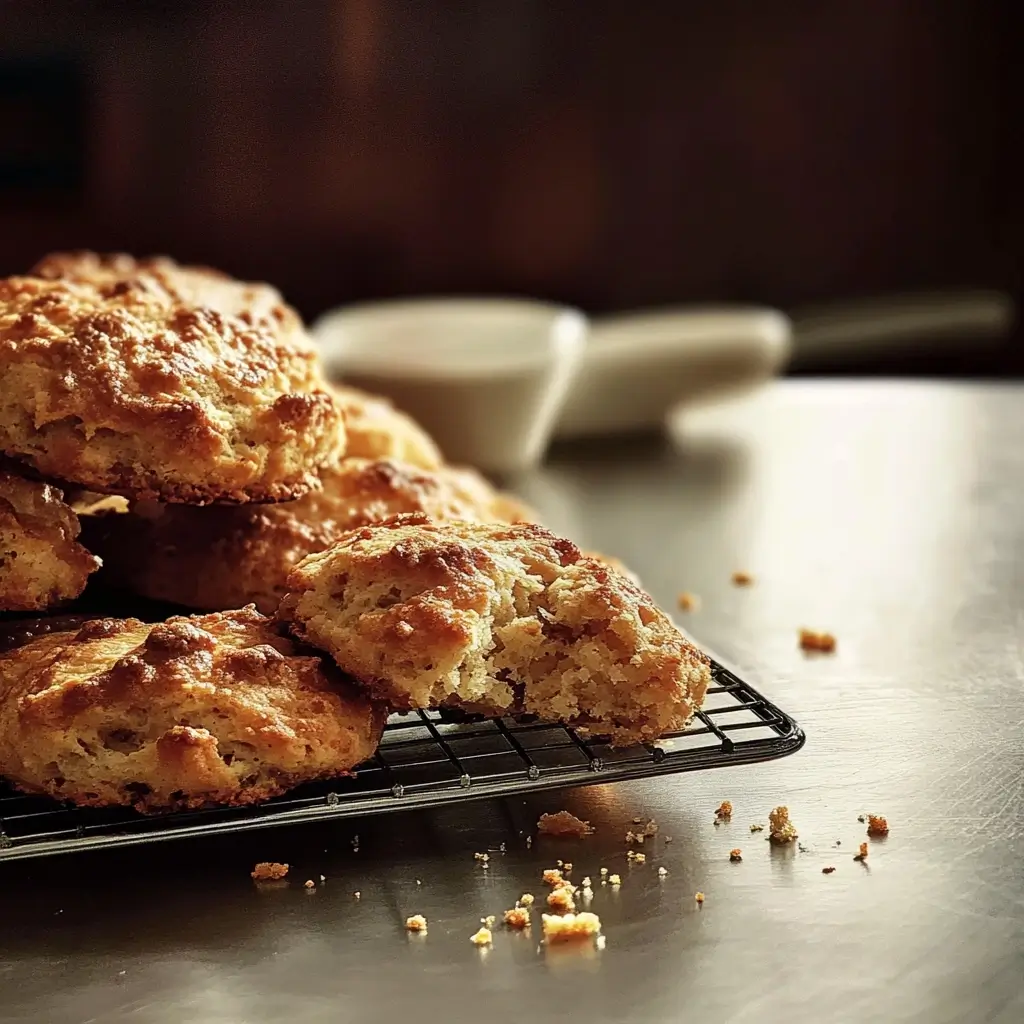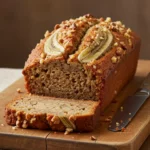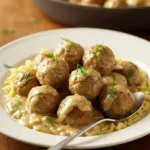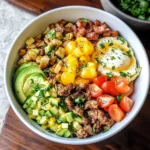From the moment the aroma of baking biscuits wafted through my kitchen, I knew this recipe was a winner. My family, self-proclaimed biscuit connoisseurs, practically hovered around the oven, their anticipation building with each passing minute. And when those golden-brown, fluffy clouds of biscuit perfection emerged, the verdict was unanimous: these Buttermilk Drop Biscuits were extraordinary. What sets them apart, besides the delightful ease of the drop biscuit method, is the subtle yet brilliant addition of chives and mustard. The Parmesan cheese adds a savory depth, while the mustard gives a gentle tang that elevates these biscuits from simple bread to something truly special. They disappeared in minutes, devoured with warm butter and honey, and plans were immediately made to bake them again for our next Sunday brunch. If you’re looking for a biscuit recipe that’s incredibly easy, wonderfully flavorful, and guaranteed to impress, look no further. These Buttermilk Chive-and-Mustard Drop Biscuits are about to become your new go-to.
Ingredients
This recipe for Buttermilk Drop Biscuits relies on simple, pantry-staple ingredients, but each plays a crucial role in creating the perfect texture and flavor. Let’s break down each component to understand its contribution and ensure you’re using the best quality for biscuit success.
- 3 cups All-Purpose Flour: The foundation of any biscuit, all-purpose flour provides the structure. It’s important to measure flour correctly – spoon it lightly into your measuring cup and level it off with a straight edge. Avoid scooping directly from the bag, as this can pack the flour and lead to using too much, resulting in dry biscuits. For a slightly more tender biscuit, you can use a lower protein all-purpose flour or even substitute a quarter of the all-purpose flour with cake flour. However, all-purpose flour is readily available and works beautifully for this recipe, delivering that classic biscuit texture we all crave.
- 2 oz. Parmesan Cheese, Grated (about 1⁄2 cup): Parmesan cheese adds a savory, nutty depth that perfectly complements the buttermilk and other flavors. It’s crucial to use freshly grated Parmesan from a block rather than pre-grated cheese. Pre-grated cheese often contains cellulose to prevent clumping, which can hinder melting and alter the texture. Grating the Parmesan on the smallest holes of a box grater ensures it’s finely distributed throughout the dough, creating a delicate cheesy flavor in every bite. If you don’t have Parmesan, you can substitute with Pecorino Romano for a sharper flavor, or Gruyère for a milder, nutty option.
- 1/4 cup Sliced Fresh Chives, Plus More for Garnish: Fresh chives bring a mild oniony and herbaceous note that brightens the biscuits and adds a touch of freshness. Use fresh chives for the best flavor; dried chives won’t provide the same vibrant taste. Slice the chives thinly to ensure they distribute evenly throughout the dough and don’t create large clumps. If you don’t have chives, you can substitute with finely chopped scallions (green onions) or fresh parsley, although chives offer the most delicate and classic flavor profile for this recipe. Don’t skip the extra chives for garnish – they add a pop of color and visual appeal to the finished biscuits.
- 1 Tbsp. Baking Powder: Baking powder is the primary leavening agent in these biscuits, responsible for their light and fluffy texture. Double-acting baking powder is recommended, as it provides leavening in both the mixing and baking stages. Ensure your baking powder is fresh; old baking powder can lose its potency and result in flat biscuits. To test its freshness, put a teaspoon of baking powder in hot water – it should bubble vigorously.
- 1 tsp. Black Pepper: Black pepper might seem unexpected in biscuits, but it adds a subtle warmth and complexity that balances the richness of the cheese and buttermilk. Freshly ground black pepper is always preferred for the most aromatic flavor. Don’t be shy with the pepper – it enhances the overall savory profile without making the biscuits spicy.
- 3/4 tsp. Kosher Salt: Salt is essential for flavor development in baking. Kosher salt is recommended for its pure flavor and consistent grain size. If using table salt, use slightly less (about 1/2 tsp), as it is finer and saltier by volume. Salt not only enhances the savory flavors but also controls the yeast activity (though these are drop biscuits and don’t use yeast, salt still plays a role in gluten development and overall flavor).
- 3/4 tsp. Garlic Powder: Garlic powder provides a subtle savory undertone that complements the Parmesan and chives. Use garlic powder rather than fresh garlic, as fresh garlic can be too strong and doesn’t distribute as evenly in the dough. Garlic powder adds a mellow, background flavor that enhances the overall savory character of the biscuits.
- 3/4 tsp. Baking Soda: Baking soda works in conjunction with the buttermilk (an acid) to create additional leavening and tenderize the biscuits. Like baking powder, ensure your baking soda is fresh for optimal results.
- 1 3/4 cups Whole Buttermilk: Buttermilk is the key ingredient that gives these biscuits their signature tang, tenderness, and moistness. The acidity of buttermilk reacts with the baking soda, creating carbon dioxide for leavening. Whole buttermilk is preferred for its richer flavor and slightly thicker consistency. If you can’t find buttermilk, you can make a substitute by adding 1 3/4 tablespoons of lemon juice or white vinegar to 1 3/4 cups of milk. Let it sit for 5-10 minutes until slightly thickened before using. However, for the best flavor and texture, real buttermilk is highly recommended.
- 3 Tbsp. Whole-Grain Mustard: Whole-grain mustard is the unexpected star of this recipe, adding a unique tangy and slightly spicy flavor. The whole mustard seeds provide a pleasant texture and visual appeal. Choose a good quality whole-grain mustard for the best flavor. Dijon mustard or yellow mustard are not suitable substitutes, as they lack the texture and distinct flavor of whole-grain mustard.
- 3/4 cup Unsalted Butter, Frozen, Plus Melted Butter for Serving: Frozen butter is crucial for creating flaky biscuits. When grated frozen butter is incorporated into the flour, it remains in small pieces and creates layers of fat within the dough. As the biscuits bake, the butter melts and releases steam, creating pockets of air and resulting in light, flaky layers. Unsalted butter is used to control the salt level in the recipe. Ensure the butter is thoroughly frozen for easy grating. Melted butter brushed on top after baking adds richness, flavor, and a beautiful golden sheen. You can use salted butter for serving if preferred.
Instructions
Making these Buttermilk Drop Biscuits is surprisingly simple and quick, perfect for busy weeknights or weekend brunches. Follow these step-by-step instructions for biscuit baking success:
- Preheat Oven to 475°F: Start by preheating your oven to a high temperature of 475°F (245°C). This high heat is essential for creating tall, fluffy biscuits with a golden-brown crust. Make sure your oven is fully preheated before placing the biscuits in, as a cold oven can affect their rise and texture.
- Combine Dry Ingredients: In a large bowl, whisk together the 3 cups of all-purpose flour, 2 oz. grated Parmesan cheese, 1/4 cup sliced fresh chives, 1 Tbsp. baking powder, 1 tsp. black pepper, 3/4 tsp. kosher salt, 3/4 tsp. garlic powder, and 3/4 tsp. baking soda. Whisking ensures all the dry ingredients are evenly distributed, which is crucial for consistent leavening and flavor throughout the biscuits.
- Whisk Wet Ingredients: In a separate small bowl, whisk together the 1 3/4 cups of whole buttermilk and 3 Tbsp. whole-grain mustard until well combined. This step ensures the mustard is evenly dispersed in the buttermilk, creating a uniform flavor in the biscuits.
- Grate Frozen Butter: This is a key step for flaky biscuits! Take your 3/4 cup of frozen unsalted butter and use the large holes of a box grater to grate it directly into the flour mixture. Work quickly to keep the butter as cold as possible. The cold, grated butter is what creates those coveted flaky layers in the biscuits.
- Coat Butter with Flour: Using your fingertips or a pastry blender, gently toss the grated butter with the flour mixture until the butter is well coated. This helps prevent the butter from melting too quickly and ensures it remains in small pieces throughout the dough. If using your fingertips, work quickly and lightly to avoid warming the butter too much.
- Add Buttermilk Mixture: Pour the buttermilk-mustard mixture into the flour mixture. Using a spatula or wooden spoon, gently stir until just combined. Do not overmix! Overmixing develops gluten, which will result in tough, dense biscuits. The dough should be shaggy and slightly sticky – it’s okay if there are still some streaks of flour.
- Drop Batter onto Baking Sheets: Line two baking sheets with parchment paper. This prevents the biscuits from sticking and makes cleanup easier. Using a 2 1/2- to 3-tablespoon cookie scoop or two spoons, drop rounded mounds of batter onto the prepared baking sheets, leaving about 3 inches of space between each biscuit. This spacing is important as the biscuits will spread slightly during baking and need room to rise properly.
- Bake: Place the baking sheets in the preheated 475°F oven. Bake for 14 to 18 minutes, or until the biscuits are golden brown on top. To ensure even baking, rotate the baking sheets between the top and bottom racks halfway through the baking time (around 7-9 minutes). Keep an eye on the biscuits; baking times may vary slightly depending on your oven.
- Brush with Melted Butter and Garnish: Once the biscuits are golden brown, remove them from the oven. Immediately brush the tops generously with melted butter. This adds richness, flavor, and a beautiful shine. Garnish with extra sliced fresh chives for a pop of color and fresh flavor.
- Serve Warm: These Buttermilk Drop Biscuits are best enjoyed warm, straight from the oven. Serve immediately with your favorite accompaniments.
Nutrition Facts
(Per biscuit, based on a yield of 24 biscuits)
- Serving Size: 1 biscuit
- Calories: Approximately 150-180 calories (depending on butter and cheese amounts)
- Fat: 8-10g
- Saturated Fat: 5-6g
- Cholesterol: 30-40mg
- Sodium: 200-250mg
- Carbohydrates: 15-18g
- Fiber: <1g
- Sugar: <1g
- Protein: 3-4g
Note: Nutritional information is an estimate and can vary based on specific ingredients and portion sizes.
Preparation Time
- Prep Time: 15 minutes
- Cook Time: 14-18 minutes
- Total Time: 30-35 minutes
These biscuits are incredibly quick to make, from start to finish in under 40 minutes!
How to Serve
These versatile Buttermilk Chive-and-Mustard Drop Biscuits are delicious in countless ways. Here are some serving suggestions to inspire you:
- Classic Breakfast or Brunch:
- Serve warm with butter, jam, honey, or fruit preserves.
- Make breakfast sandwiches with scrambled eggs, cheese, and your choice of breakfast meat like bacon, sausage, or ham.
- Pair them with a side of creamy grits or breakfast potatoes for a hearty Southern-style breakfast.
- Savory Lunch or Dinner Companions:
- Soup Dippers: As suggested in the original recipe, these biscuits are fantastic dipped in creamy soups like Creamy Chicken and Rice Soup, tomato soup, or potato soup.
- Stew Accompaniment: Serve alongside hearty stews like beef stew, chili, or chicken stew to soak up the flavorful broth.
- Side with Roasted Meats: Pair them with roasted chicken, pork, or beef for a comforting and satisfying meal.
- Sandwiches: Split them open and use them as sandwich bread for ham and cheese, turkey, or roast beef sandwiches. The mustard flavor in the biscuits pairs especially well with ham.
- Appetizers or Snacks:
- Mini Biscuit Bites: Make smaller biscuits (using a smaller scoop) for bite-sized appetizers. Serve with savory dips like spinach artichoke dip, cheese dip, or ranch dressing.
- Cheese and Charcuterie Board Addition: Include warm biscuits on a cheese and charcuterie board for a delightful savory element.
- Special Occasions:
- Holiday Bread Basket: Add these biscuits to your holiday bread basket for Thanksgiving, Christmas, or Easter. Their unique flavor and ease of preparation make them a crowd-pleaser.
- Potlucks and Gatherings: Bring a batch of warm biscuits to potlucks, picnics, or family gatherings – they are always a hit!
Additional Tips for Perfect Buttermilk Drop Biscuits
To ensure your Buttermilk Chive-and-Mustard Drop Biscuits turn out perfectly every time, here are five essential tips:
- Keep Ingredients Cold: The key to flaky biscuits is cold butter. Make sure your butter is thoroughly frozen before grating it. Even the buttermilk should be cold. Cold ingredients prevent the butter from melting into the flour before baking, which is crucial for creating those light, airy layers. Some bakers even chill their flour and mixing bowl for optimal results, especially in warmer climates.
- Don’t Overmix the Dough: Overmixing is the biggest mistake bakers make when preparing biscuits. Once you add the buttermilk mixture to the dry ingredients, stir just until everything is barely combined. A few streaks of flour are perfectly fine. Overmixing develops gluten, resulting in tough, dense, and less tender biscuits. Gentle handling is key for light and fluffy biscuits.
- Use Parchment Paper: Always bake biscuits on parchment-lined baking sheets. Parchment paper prevents sticking, ensures even baking, and makes cleanup a breeze. It also helps to lift the biscuits off the hot baking sheet after baking, preventing the bottoms from over-browning.
- High Oven Temperature is Crucial: The high oven temperature of 475°F (245°C) is not just a suggestion; it’s essential for creating the right texture and rise in drop biscuits. The high heat causes the butter to melt quickly and release steam, creating lift and flakiness. It also helps the biscuits to brown beautifully on top. Make sure your oven is fully preheated before baking.
- Handle Dough Gently When Dropping: When dropping the biscuit batter onto the baking sheets, use a light hand. Avoid pressing or shaping the mounds of dough too much. Gently scoop or spoon the batter and let it drop naturally onto the parchment. Over-handling can compress the dough and lead to denser biscuits. The rustic, slightly uneven shape of drop biscuits is part of their charm!
Frequently Asked Questions (FAQ)
Here are some common questions about making Buttermilk Drop Biscuits, along with helpful answers to ensure your baking experience is smooth and successful:
Q1: Can I use salted butter instead of unsalted butter?
A: Yes, you can use salted butter, but you will need to reduce the amount of kosher salt in the recipe. If using salted butter, reduce the kosher salt to 1/4 teaspoon. Keep in mind that salted butter can vary in salt content between brands, so unsalted butter gives you more control over the final saltiness of the biscuits.
Q2: I don’t have buttermilk. Can I use regular milk?
A: While buttermilk is highly recommended for its flavor and texture, you can substitute it in a pinch. To make a buttermilk substitute, add 1 3/4 tablespoons of lemon juice or white vinegar to 1 3/4 cups of milk. Stir and let it sit for 5-10 minutes until it slightly thickens and curdles. This will mimic the acidity of buttermilk, but the flavor and texture may not be quite as rich or tangy as with real buttermilk.
Q3: Can I make these biscuits ahead of time?
A: Biscuits are best enjoyed fresh and warm from the oven. However, you can prepare the dough ahead of time and keep it chilled in the refrigerator for up to 2 hours before baking. Drop the biscuits onto baking sheets just before baking. Alternatively, you can bake the biscuits ahead of time and reheat them gently in a low oven (around 300°F or 150°C) for 5-10 minutes to warm them through before serving. They will be best within the first day of baking.
Q4: My biscuits are flat and dense. What went wrong?
A: Flat, dense biscuits are often caused by a few common mistakes:
* Overmixing: Overmixing develops gluten, leading to tough biscuits. Be gentle and mix just until combined.
* Warm Butter: If the butter wasn’t cold enough, it may have melted into the flour, preventing the formation of flaky layers. Ensure your butter is frozen and handle it quickly.
* Old Leavening Agents: Expired baking powder or baking soda can lose their potency. Check the expiration dates and test their freshness if you’re unsure.
* Oven Temperature Too Low: A low oven temperature can prevent the biscuits from rising properly. Ensure your oven is preheated to 475°F (245°C).
Q5: Can I add other flavors to these biscuits?
A: Absolutely! These Buttermilk Drop Biscuits are a great base for experimenting with flavors. Here are some variations you can try:
* Cheese Variations: Try using different cheeses like cheddar, Monterey Jack, or Gruyère instead of or in addition to Parmesan.
* Herb Variations: Experiment with other fresh herbs like dill, thyme, rosemary, or sage instead of or in addition to chives.
* Spicy Biscuits: Add a pinch of cayenne pepper or red pepper flakes for a touch of heat.
* Sweet Biscuits (less savory ingredients): Reduce or omit the cheese, garlic powder, pepper, mustard and add a tablespoon or two of sugar for slightly sweeter biscuits, perfect for serving with fruit and whipped cream.
Enjoy baking these delightful Buttermilk Chive-and-Mustard Drop Biscuits! They are sure to become a cherished recipe in your kitchen.
Print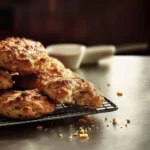
Buttermilk Drop Biscuits Recipe
Ingredients
- 3 cups All-Purpose Flour: The foundation of any biscuit, all-purpose flour provides the structure. It’s important to measure flour correctly – spoon it lightly into your measuring cup and level it off with a straight edge. Avoid scooping directly from the bag, as this can pack the flour and lead to using too much, resulting in dry biscuits. For a slightly more tender biscuit, you can use a lower protein all-purpose flour or even substitute a quarter of the all-purpose flour with cake flour. However, all-purpose flour is readily available and works beautifully for this recipe, delivering that classic biscuit texture we all crave.
- 2 oz. Parmesan Cheese, Grated (about 1⁄2 cup): Parmesan cheese adds a savory, nutty depth that perfectly complements the buttermilk and other flavors. It’s crucial to use freshly grated Parmesan from a block rather than pre-grated cheese. Pre-grated cheese often contains cellulose to prevent clumping, which can hinder melting and alter the texture. Grating the Parmesan on the smallest holes of a box grater ensures it’s finely distributed throughout the dough, creating a delicate cheesy flavor in every bite. If you don’t have Parmesan, you can substitute with Pecorino Romano for a sharper flavor, or Gruyère for a milder, nutty option.
- 1/4 cup Sliced Fresh Chives, Plus More for Garnish: Fresh chives bring a mild oniony and herbaceous note that brightens the biscuits and adds a touch of freshness. Use fresh chives for the best flavor; dried chives won’t provide the same vibrant taste. Slice the chives thinly to ensure they distribute evenly throughout the dough and don’t create large clumps. If you don’t have chives, you can substitute with finely chopped scallions (green onions) or fresh parsley, although chives offer the most delicate and classic flavor profile for this recipe. Don’t skip the extra chives for garnish – they add a pop of color and visual appeal to the finished biscuits.
- 1 Tbsp. Baking Powder: Baking powder is the primary leavening agent in these biscuits, responsible for their light and fluffy texture. Double-acting baking powder is recommended, as it provides leavening in both the mixing and baking stages. Ensure your baking powder is fresh; old baking powder can lose its potency and result in flat biscuits. To test its freshness, put a teaspoon of baking powder in hot water – it should bubble vigorously.
- 1 tsp. Black Pepper: Black pepper might seem unexpected in biscuits, but it adds a subtle warmth and complexity that balances the richness of the cheese and buttermilk. Freshly ground black pepper is always preferred for the most aromatic flavor. Don’t be shy with the pepper – it enhances the overall savory profile without making the biscuits spicy.
- 3/4 tsp. Kosher Salt: Salt is essential for flavor development in baking. Kosher salt is recommended for its pure flavor and consistent grain size. If using table salt, use slightly less (about 1/2 tsp), as it is finer and saltier by volume. Salt not only enhances the savory flavors but also controls the yeast activity (though these are drop biscuits and don’t use yeast, salt still plays a role in gluten development and overall flavor).
- 3/4 tsp. Garlic Powder: Garlic powder provides a subtle savory undertone that complements the Parmesan and chives. Use garlic powder rather than fresh garlic, as fresh garlic can be too strong and doesn’t distribute as evenly in the dough. Garlic powder adds a mellow, background flavor that enhances the overall savory character of the biscuits.
- 3/4 tsp. Baking Soda: Baking soda works in conjunction with the buttermilk (an acid) to create additional leavening and tenderize the biscuits. Like baking powder, ensure your baking soda is fresh for optimal results.
- 1 3/4 cups Whole Buttermilk: Buttermilk is the key ingredient that gives these biscuits their signature tang, tenderness, and moistness. The acidity of buttermilk reacts with the baking soda, creating carbon dioxide for leavening. Whole buttermilk is preferred for its richer flavor and slightly thicker consistency. If you can’t find buttermilk, you can make a substitute by adding 1 3/4 tablespoons of lemon juice or white vinegar to 1 3/4 cups of milk. Let it sit for 5–10 minutes until slightly thickened before using. However, for the best flavor and texture, real buttermilk is highly recommended.
- 3 Tbsp. Whole-Grain Mustard: Whole-grain mustard is the unexpected star of this recipe, adding a unique tangy and slightly spicy flavor. The whole mustard seeds provide a pleasant texture and visual appeal. Choose a good quality whole-grain mustard for the best flavor. Dijon mustard or yellow mustard are not suitable substitutes, as they lack the texture and distinct flavor of whole-grain mustard.
- 3/4 cup Unsalted Butter, Frozen, Plus Melted Butter for Serving: Frozen butter is crucial for creating flaky biscuits. When grated frozen butter is incorporated into the flour, it remains in small pieces and creates layers of fat within the dough. As the biscuits bake, the butter melts and releases steam, creating pockets of air and resulting in light, flaky layers. Unsalted butter is used to control the salt level in the recipe. Ensure the butter is thoroughly frozen for easy grating. Melted butter brushed on top after baking adds richness, flavor, and a beautiful golden sheen. You can use salted butter for serving if preferred.
Instructions
- Preheat Oven to 475°F: Start by preheating your oven to a high temperature of 475°F (245°C). This high heat is essential for creating tall, fluffy biscuits with a golden-brown crust. Make sure your oven is fully preheated before placing the biscuits in, as a cold oven can affect their rise and texture.
- Combine Dry Ingredients: In a large bowl, whisk together the 3 cups of all-purpose flour, 2 oz. grated Parmesan cheese, 1/4 cup sliced fresh chives, 1 Tbsp. baking powder, 1 tsp. black pepper, 3/4 tsp. kosher salt, 3/4 tsp. garlic powder, and 3/4 tsp. baking soda. Whisking ensures all the dry ingredients are evenly distributed, which is crucial for consistent leavening and flavor throughout the biscuits.
- Whisk Wet Ingredients: In a separate small bowl, whisk together the 1 3/4 cups of whole buttermilk and 3 Tbsp. whole-grain mustard until well combined. This step ensures the mustard is evenly dispersed in the buttermilk, creating a uniform flavor in the biscuits.
- Grate Frozen Butter: This is a key step for flaky biscuits! Take your 3/4 cup of frozen unsalted butter and use the large holes of a box grater to grate it directly into the flour mixture. Work quickly to keep the butter as cold as possible. The cold, grated butter is what creates those coveted flaky layers in the biscuits.
- Coat Butter with Flour: Using your fingertips or a pastry blender, gently toss the grated butter with the flour mixture until the butter is well coated. This helps prevent the butter from melting too quickly and ensures it remains in small pieces throughout the dough. If using your fingertips, work quickly and lightly to avoid warming the butter too much.
- Add Buttermilk Mixture: Pour the buttermilk-mustard mixture into the flour mixture. Using a spatula or wooden spoon, gently stir until just combined. Do not overmix! Overmixing develops gluten, which will result in tough, dense biscuits. The dough should be shaggy and slightly sticky – it’s okay if there are still some streaks of flour.
- Drop Batter onto Baking Sheets: Line two baking sheets with parchment paper. This prevents the biscuits from sticking and makes cleanup easier. Using a 2 1/2- to 3-tablespoon cookie scoop or two spoons, drop rounded mounds of batter onto the prepared baking sheets, leaving about 3 inches of space between each biscuit. This spacing is important as the biscuits will spread slightly during baking and need room to rise properly.
- Bake: Place the baking sheets in the preheated 475°F oven. Bake for 14 to 18 minutes, or until the biscuits are golden brown on top. To ensure even baking, rotate the baking sheets between the top and bottom racks halfway through the baking time (around 7-9 minutes). Keep an eye on the biscuits; baking times may vary slightly depending on your oven.
- Brush with Melted Butter and Garnish: Once the biscuits are golden brown, remove them from the oven. Immediately brush the tops generously with melted butter. This adds richness, flavor, and a beautiful shine. Garnish with extra sliced fresh chives for a pop of color and fresh flavor.
- Serve Warm: These Buttermilk Drop Biscuits are best enjoyed warm, straight from the oven. Serve immediately with your favorite accompaniments.
Nutrition
- Serving Size: One Normal Portion
- Calories: 150-180
- Sugar: <1g
- Sodium: 200-250mg
- Fat: 8-10g
- Saturated Fat: 5-6g
- Carbohydrates: 15-18g
- Fiber: <1g
- Protein: 3-4g
- Cholesterol: 30-40mg


